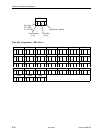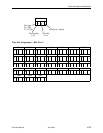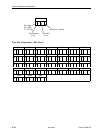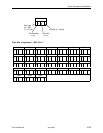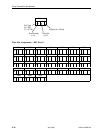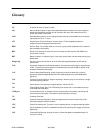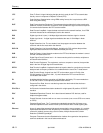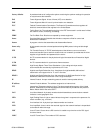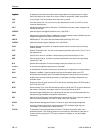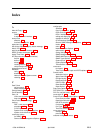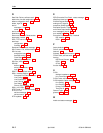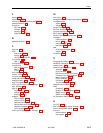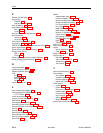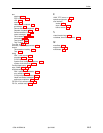
Glossary
GL-4
8700-A2-GB20-00
April 2000
A diagnostic procedure that sends a test message back to its origination point. Used to
test various portions of a data link in order to isolate an equipment or data line problem.
Loss of Signal. The line condition where there are no pulses.
Line Termination Unit. The control unit on the network end of a link. (The NTU is on the
customer premises end.)
Management Communications Controller. The DSLAM circuit card used to configure and
monitor the DSLAM.
Multirate High-bit-rate Digital Subscriber Line. (See HDSL.)
Management Information Base. A database of managed objects used by SNMP to provide
network management information and device control.
MIB Release 2. The current Internet-standard MIB, defined by RFC 1213.
Multirate Symmetric Digital Subscriber Line. (See SDSL.)
Network Management System. A computer system used for monitoring and controlling
network devices.
Network Termination Unit. The unit on the customer premises end of a link. (The LTU is on
the network end.)
Out Of Frame. An error condition in which frame synchronization bits are in error.
Point-to-Point Protocol. A protocol for packet transmission over serial links, specified by
Internet RFC 1661.
Remote Alarm Indication. A failure message sent by the remote unit in a link.
A circuit that accepts data signals from a transmitter.
A reinitialization of the device that occurs at power-up or in response to a reset command.
Repeater LoopBack. Loops the signal being sent to the network back to the DTE
Drop/Insert and data ports after it has passed through the framing circuitry of the device.
A device that connects LANs by dynamically routing data according to destination and
available routes.
Request to Send. A signal from the DTE to the device, indicating that the DTE has data to
send. V.24 circuit 105.
Received Data. Pin 3 of the EIA-232 interface that is used by the DTE to receive data from
the modem. Conversely, the modem uses Pin 3 to transmit data to the DTE.
Symmetric Digital Subscriber Line. A technique for the use of an existing twisted-pair line
that permits high bandwidth, bidirectional transmission.
Severely Errored Seconds. Usually defined as a second during which a specific number of
CRC errors was exceeded, or an OOF or other critical error occurred.
Simple Network Management Protocol. Protocol for open networking management.
A term for a digital carrier facility used to transmit a DS1 formatted digital signal at
1.544 Mbps. It is used primarily in North America.
Transmission Control Protocol/Internet Protocol. The dominant protocol suite in the
worldwide Internet, TCP allows a process on one machine to send data to a process on
another machine using the IP. TCP can be used as a full-duplex or one-way simplex
connection.
loopbackloopback
LOS
LTU
MCC
M/HDSL
MIB
MIB II
M/SDSL
NMS
NTU
OOF
PPP
RAI
receiver
reset
RLB
router
RTS
RXD
SDSL
SES
SNMP
T1
TCP/IP



